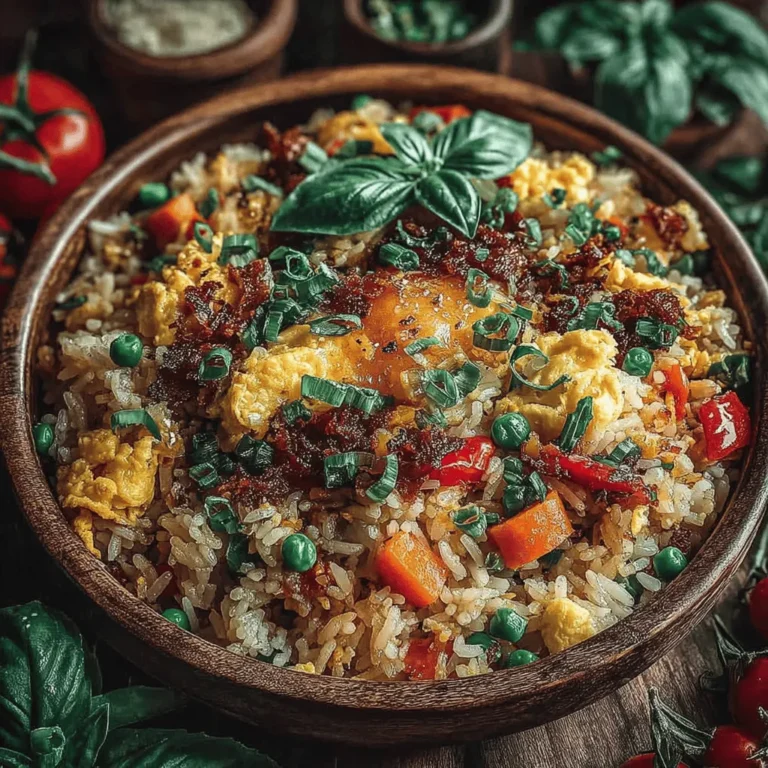Introduction to Balsamic Vinaigrette Fried Rice
In the world of culinary creativity, fried rice stands out as a versatile dish that invites experimentation and personalization. Traditionally celebrated for its ability to incorporate a variety of ingredients, fried rice serves as a blank canvas, ready to absorb flavors and textures that reflect the cook’s imagination. If you’re looking to elevate your fried rice game with a unique twist, the Balsamic Vinaigrette Fried Rice recipe is a delightful option. This innovative dish seamlessly combines the savory elements of traditional fried rice with the tangy richness of balsamic vinaigrette, creating a meal that is both satisfying and sophisticated.
What sets Balsamic Vinaigrette Fried Rice apart is its ability to transform leftover rice into a gourmet experience. This dish is not only quick and easy to prepare but also allows you to utilize ingredients you may already have on hand. Whether you have a busy weeknight ahead or are looking to impress guests with a creative culinary offering, this recipe delivers on both flavor and convenience. In this article, we will explore the essential ingredients, step-by-step instructions, and the overall appeal of Balsamic Vinaigrette Fried Rice, ensuring that you have the knowledge to create this flavorful masterpiece in the comfort of your kitchen.
Understanding the Ingredients
The foundation of any great recipe lies in its ingredients. For Balsamic Vinaigrette Fried Rice, understanding the role and significance of each component is crucial in achieving a harmonious balance of flavors and textures.
The Role of Cooked Rice
When it comes to fried rice, texture is key. The best results come from using day-old or leftover rice, which has had time to cool and dry out slightly. Freshly cooked rice tends to be too moist, resulting in clumps when stir-fried. Day-old rice, on the other hand, boasts a firmer texture, allowing each grain to separate beautifully during cooking. This not only enhances the mouthfeel but also ensures that the rice absorbs the flavors of the added ingredients, particularly the balsamic vinaigrette, resulting in a more savory and cohesive dish.
The Significance of Fresh Vegetables
Incorporating a colorful mix of fresh vegetables is essential for both nutritional benefits and flavor enhancement. Vegetables such as bell peppers, carrots, peas, and green onions add crunch, color, and a variety of vitamins and minerals. They contribute to the dish’s overall healthiness while also providing a fresh contrast to the rich and tangy balsamic vinaigrette. Additionally, the vibrant hues of the vegetables make the dish visually appealing, enticing diners to indulge in this culinary creation.
The Impact of Balsamic Vinaigrette
The star player in this recipe is undoubtedly the balsamic vinaigrette. This condiment adds a depth of flavor that transforms ordinary fried rice into a gourmet experience. The sweetness and acidity of the balsamic vinegar complement the savory notes of the other ingredients, creating a well-rounded profile that tantalizes the palate. Moreover, the vinaigrette acts as a marinade, allowing the flavors to meld beautifully with the rice and vegetables, ensuring that every bite is packed with deliciousness.
The Importance of Eggs
Eggs are a classic addition to fried rice, and for good reason. They not only contribute to the dish’s protein content but also create a satisfying texture. When cooked correctly, scrambled eggs become soft and fluffy, providing a creamy contrast to the crunchy vegetables and the firm rice. Their neutral flavor also allows them to blend seamlessly with the other ingredients, enhancing the overall richness of the dish. In Balsamic Vinaigrette Fried Rice, the eggs are essential for achieving that classic fried rice experience, ensuring that each serving is both hearty and wholesome.
Step-by-Step Instructions for Preparation
Now that we have a clear understanding of the ingredients, let’s dive into the preparation process. This section will provide a comprehensive guide to preparing Balsamic Vinaigrette Fried Rice, ensuring that readers can follow along easily and achieve delicious results.
Creating the Flavor Base
To start, you’ll want to create a robust flavor base for your fried rice. Begin by heating a tablespoon of oil—such as vegetable or canola oil—in a large skillet or wok over medium-high heat. Once the oil is shimmering, add finely chopped onions and minced garlic to the pan. Sauté the onions until they become translucent and fragrant, which usually takes about 2-3 minutes. This initial step is crucial, as it builds the savory foundation upon which the rest of the dish will be layered. For an added depth of flavor, consider using a splash of soy sauce during the sautéing process; this will enhance the umami profile of your flavor base.
Incorporating Vegetables
After the onions and garlic are perfectly sautéed, it’s time to add your selection of fresh vegetables. Aim for a colorful mix—think diced bell peppers, shredded carrots, and frozen peas—for a vibrant and nutritious addition. Add the vegetables to the skillet, stirring frequently to ensure even cooking. Depending on the type of vegetables you choose, the cooking time may vary; however, aim to maintain their crispness. For softer vegetables like zucchini or mushrooms, you may want to add them slightly earlier in the cooking process. The goal is to achieve a balance where the vegetables remain tender yet retain a satisfying crunch, adding texture to your fried rice.
Cooking the Eggs to Perfection
With the vegetables sautéed to your liking, it’s time to add the eggs. Push the vegetable mixture to one side of the skillet, creating a small space for the eggs. Crack 2-3 eggs into this space, allowing them to scramble in the pan. Stir the eggs gently, ensuring they cook evenly without sticking to the bottom. A useful tip is to lower the heat slightly during this step to prevent the eggs from cooking too quickly. Once the eggs are fully scrambled and just set, mix them into the vegetable medley, creating a colorful and protein-rich base for your fried rice.
Stirring in the Rice
Now that your flavorful base is ready, it’s time to incorporate the star of the dish—the cooked rice. Add your day-old rice to the skillet, breaking up any clumps with a spatula. Stir gently to combine the rice with the sautéed vegetables and scrambled eggs, ensuring that everything is evenly distributed. This is the moment where you can enhance the dish’s flavor profile even further by drizzling in your balsamic vinaigrette. Start with a couple of tablespoons, adjusting to taste as you mix everything together. The vinaigrette will coat the rice and vegetables, infusing them with its tangy and sweet notes.
As the rice begins to heat through, continue to stir and toss the mixture, allowing the flavors to meld beautifully. Cooking on high heat for a few minutes will help achieve that characteristic fried rice texture, as the rice takes on a slightly crispy exterior while remaining tender on the inside.
In the next section of this article, we will continue to explore additional tips for perfecting Balsamic Vinaigrette Fried Rice, including serving suggestions and variations to customize this dish to your preference. Stay tuned to learn how to take your fried rice to the next level.
{{image_2}}
Achieving the Perfect Fried Texture
When it comes to making fried rice, achieving that desirable texture is essential. Begin by breaking apart any clumps of rice. This is crucial because clumped rice will not fry evenly, resulting in a dish that’s unevenly cooked and lacking in texture. To break apart the rice, you can use a fork or your fingers, gently separating the grains without crushing them. If you’re using leftover rice, it’s best to refrigerate it overnight as this allows the grains to dry out slightly, making them easier to handle.
When it’s time to fry the rice, ensure your pan is hot before adding any ingredients. A hot pan helps to create that coveted crispy texture. Use a non-stick skillet or a well-seasoned wok for best results. Add a drizzle of oil to the pan and wait until it shimmers before you introduce the rice. This will help to seal the moisture in the rice and create a deliciously crispy exterior. Stir continuously to ensure the rice is evenly fried, which will help to prevent any burning while allowing for an even distribution of heat.
Seasoning for Flavor
Seasoning is where the magic happens in fried rice, and in the case of Balsamic Vinaigrette Fried Rice, the balance between balsamic vinaigrette and soy sauce is pivotal. Start with a base of soy sauce, which adds that essential umami flavor. Depending on your taste, you can use regular, low-sodium, or gluten-free soy sauce. Begin with one tablespoon of soy sauce and taste as you go.
Next, introduce the balsamic vinaigrette. This ingredient provides a tangy sweetness that beautifully complements the soy sauce. Start with one tablespoon of balsamic vinaigrette and mix it well with the rice. Taste the rice after incorporating both sauces, and adjust accordingly. If you prefer a tangier flavor, add more balsamic vinaigrette; if you want more depth, increase the soy sauce. The key is to create a harmonious blend that enhances the overall flavor profile of your dish.
Final Touches and Presentation
The final touches of your Balsamic Vinaigrette Fried Rice can elevate your dish from simple to stunning. To ensure an even coating of the vinaigrette and soy sauce, toss the rice thoroughly in the pan. Use a spatula to gently fold the rice, making sure every grain is coated without breaking it apart. This step is crucial as it allows the flavors to meld together, providing a consistent taste throughout.
Presentation is equally important when serving fried rice. First, consider the plating. Use a large shallow bowl or plate to allow the rice to spread out, making it visually appealing. For an extra touch, you can use a ring mold to create a neat stack of rice in the center of the plate, which adds height and sophistication.
Garnishing is the final step to enhance visual appeal. Finely chopped green onions, sesame seeds, or a sprinkle of fresh herbs like parsley or cilantro can elevate the dish’s presentation. A drizzle of additional balsamic vinaigrette on top can also add a beautiful sheen to the dish.
The Appeal of Balsamic Vinaigrette Fried Rice
Balsamic Vinaigrette Fried Rice stands out among traditional fried rice dishes due to its unique combination of flavors and versatility. The tangy balsamic vinegar infuses the rice with a refreshing zest, creating a delightful contrast to the savory notes of soy sauce. This dish strays from the ordinary, making it an exciting option for both culinary adventurers and those looking for a new twist on an old favorite.
Flavor Profile Overview
The flavor profile of Balsamic Vinaigrette Fried Rice is a symphony of taste. The tanginess from the balsamic vinaigrette plays beautifully against the umami-rich soy sauce. Additionally, the sweetness of the balsamic adds layers of complexity, while the fried vegetables contribute a crunch that enhances each bite. The balance of these flavors—tangy, savory, sweet, and umami—creates a delicious dish that is both satisfying and refreshing.
Versatility for Various Dietary Needs
One of the most appealing aspects of this fried rice recipe is its adaptability. It can easily cater to a variety of dietary restrictions. For vegetarians and vegans, simply ensure that the soy sauce used is plant-based, and you can add a variety of vegetables such as bell peppers, peas, and carrots to enhance the dish. For those following a gluten-free diet, swap out regular soy sauce for a gluten-free version or use tamari, which provides similar flavor without gluten. This adaptability makes Balsamic Vinaigrette Fried Rice a dish that everyone can enjoy.
Perfect for Leftovers
This recipe also shines when it comes to practicality, particularly for those looking to reduce food waste. Balsamic Vinaigrette Fried Rice is a fantastic way to use up leftover rice and any vegetables you may have sitting in the fridge. It’s a sustainable choice that not only minimizes waste but also transforms simple leftovers into an extraordinary meal. By taking advantage of what you have on hand, you can create a flavorful dish that delights your palate.
Nutritional Benefits of Balsamic Vinaigrette Fried Rice
In addition to its deliciousness, Balsamic Vinaigrette Fried Rice also offers various nutritional benefits, making it a well-rounded meal option.
Macronutrient Breakdown
Each serving of Balsamic Vinaigrette Fried Rice typically contains about 250-300 calories, depending on the amount of oil and additional ingredients used. The dish provides a healthy balance of macronutrients, including approximately 8-10 grams of protein, 5-7 grams of fat, and 40-45 grams of carbohydrates. The inclusion of vegetables adds fiber, which is beneficial for digestion and contributes to a feeling of fullness.
Vitamin and Mineral Highlights
This recipe is rich in vitamins and minerals, thanks to its diverse ingredients. Common vegetables used—like carrots, peas, and bell peppers—are excellent sources of vitamins A and C, which are vital for immune function and skin health. Additionally, the balsamic vinaigrette, often made with olive oil, provides heart-healthy fats, which can help reduce inflammation. The combination of these ingredients ensures that your meal is not just tasty but also packed with essential nutrients.
Conclusion: Embracing Culinary Creativity with Balsamic Vinaigrette Fried Rice
In conclusion, Balsamic Vinaigrette Fried Rice is a delicious and innovative take on a classic dish that allows for culinary creativity while reducing food waste. By incorporating simple yet flavorful ingredients, this recipe serves as an example of how leftovers can be transformed into something extraordinary. Whether enjoyed as a main dish or a side, this fried rice recipe is bound to impress both family and friends, making it a worthy addition to your culinary repertoire.
Embrace the versatility and rich flavor profile of Balsamic Vinaigrette Fried Rice, and let it inspire your next meal. With its balance of taste and nutrition, this dish is not only a feast for the palate but also a practical choice for your kitchen. So gather your ingredients, fire up that skillet, and enjoy the delightful experience of creating this unique culinary delight.


